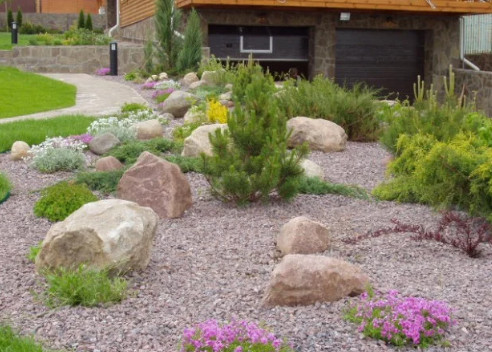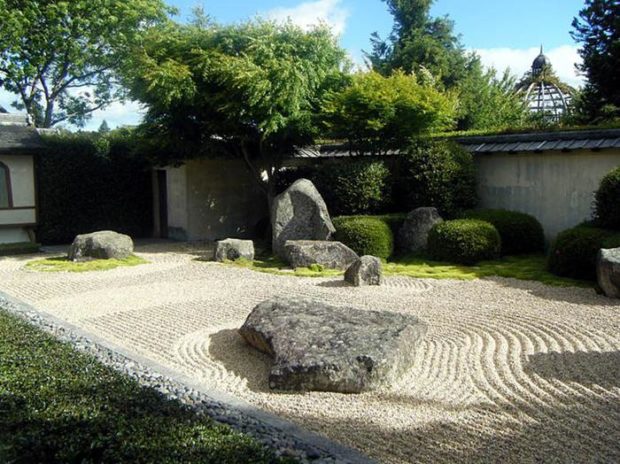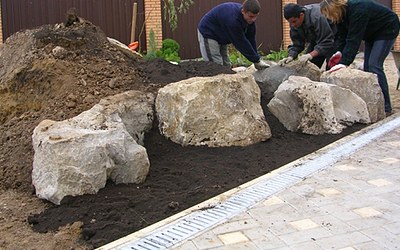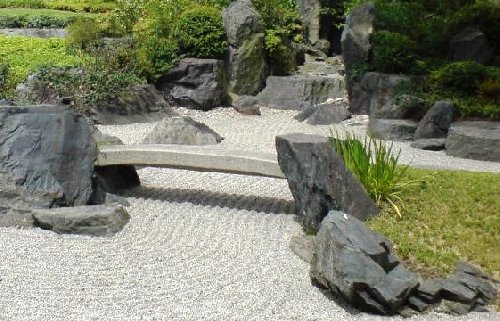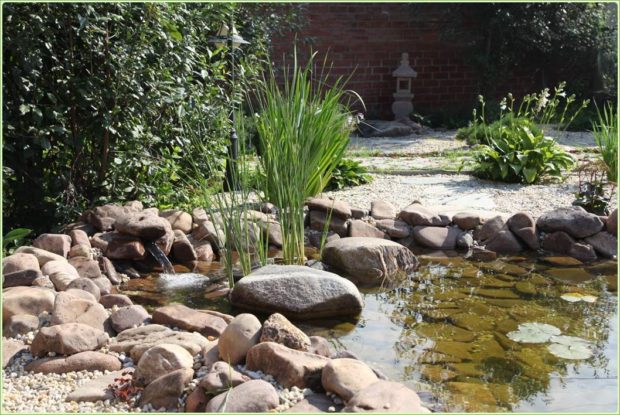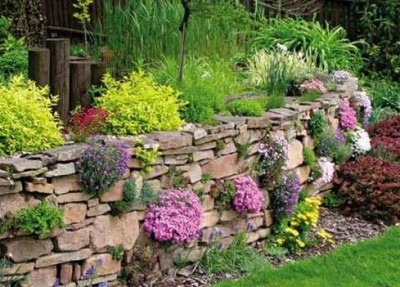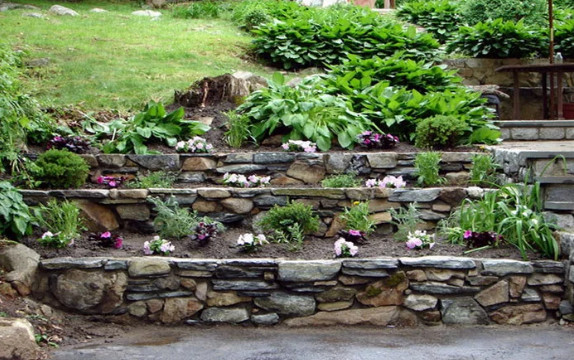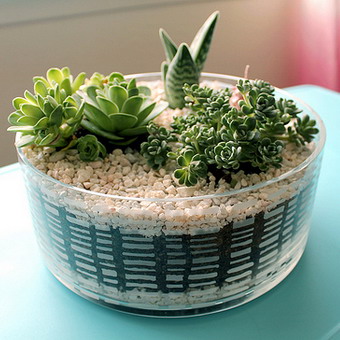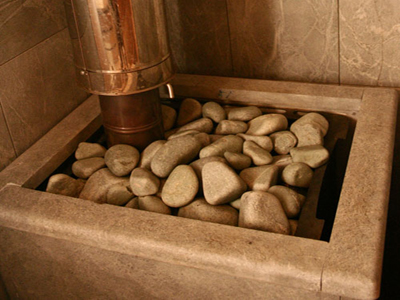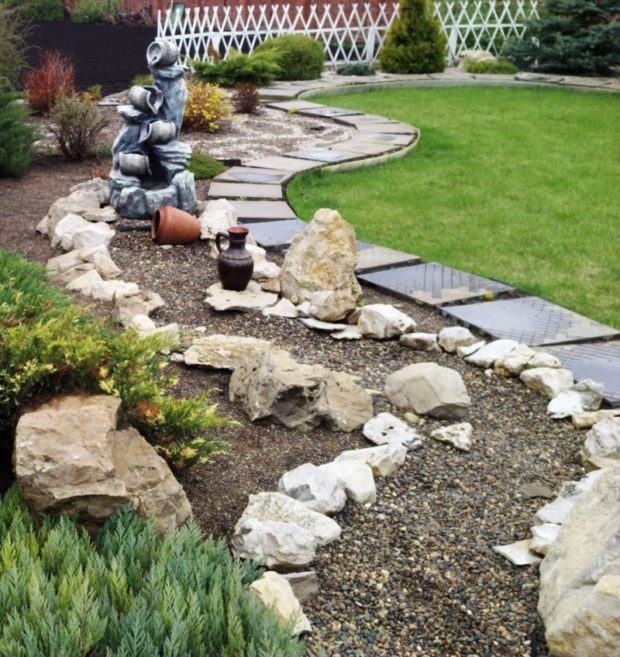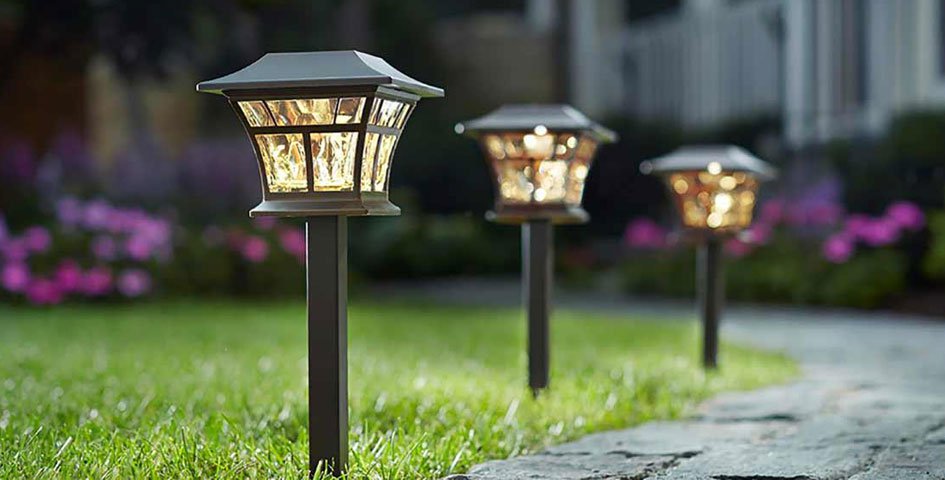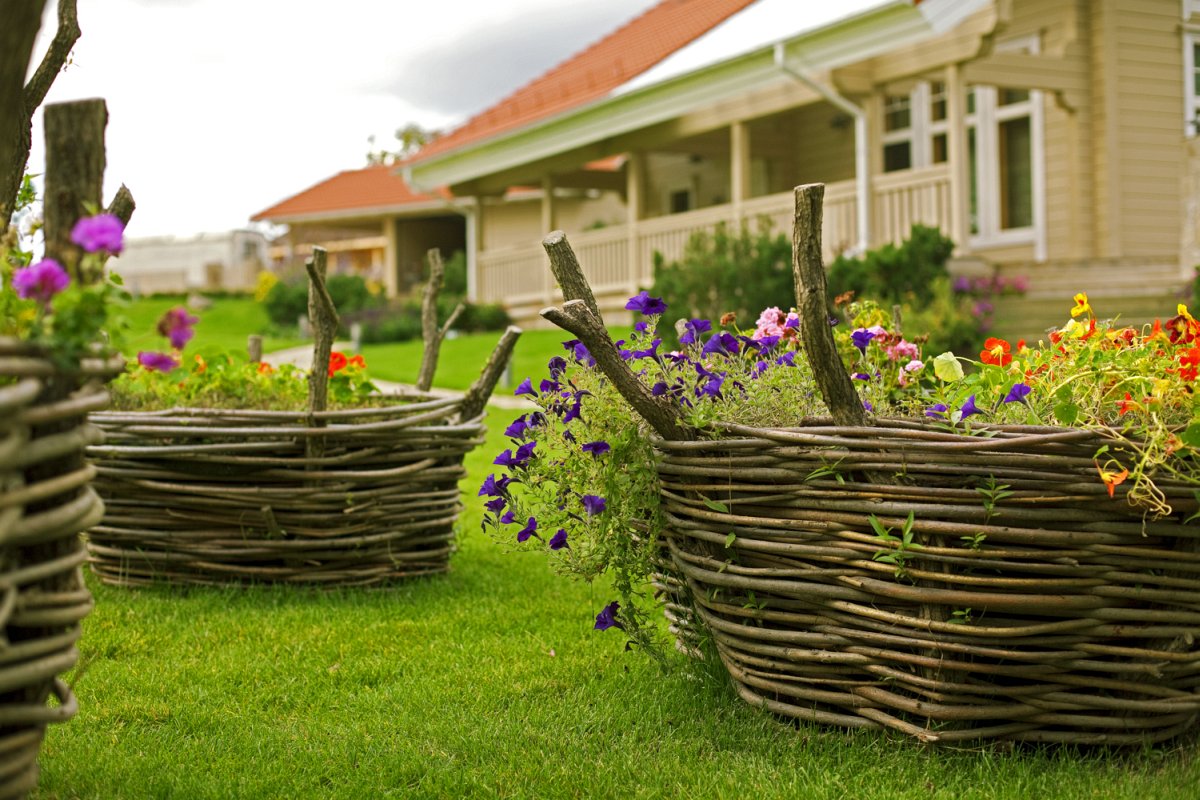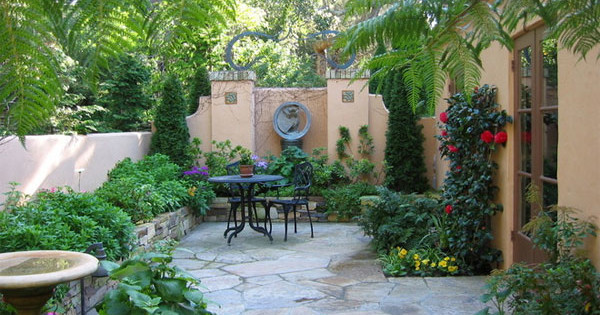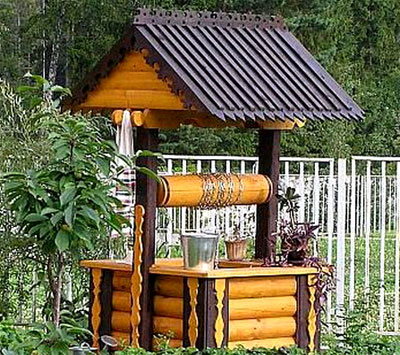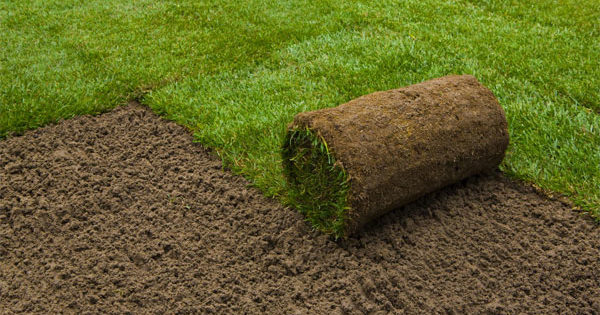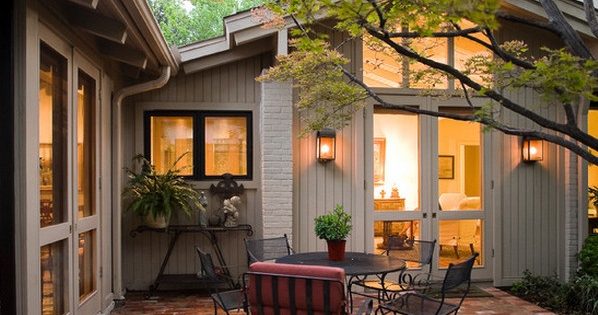DIY rock garden: 9 tips for organizing + photos
How to decorate a country or suburban area? Flowerbed? By a pond? By the garden? Good options, but you can try to implement something more interesting. For example, a rock garden. Previously, the stony landscape on the site was reduced exclusively to the creation of slides. Today designers have opened up a lot of new ways for us to use stones, and one of them is the creation of a Japanese rock garden, which gives peace and tranquility. In his homeland, in Japan, only masters are engaged in such gardens, since for residents of the land of the rising sun it is part of religion and culture. For us, this is just an unusual decoration, so absolutely everyone can create a stone garden with their own hands in the country. True, in order for the venture to produce the expected results, it is nevertheless necessary to take into account some key principles and ideas.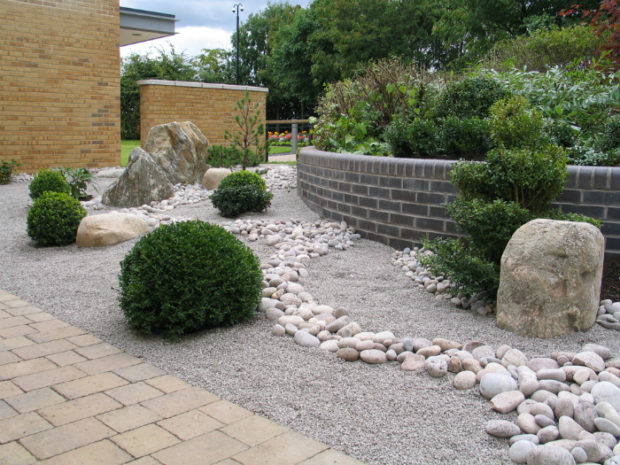
No. 1. Key ideas of the Japanese rock garden
Stone gardens began to be built in Japanwhere to this day they make a huge sense. Thanks to the accelerated pace of globalization, rock gardens have spread around the world, have gained decent popularity in the USA and European countries, and now they have begun to conquer domestic summer cottages.
That phrase, which we translate as “rock garden”, literally translates from Japanese as "Dry mountains and waters." Legend has it that one day a sailor rescued a turtle, which, trying to thank him, showed him one of three go five islands, where immortals live. Three or five is still a matter of debate. Nevertheless, there should be an odd number of stones in the garden, and it is desirable that their number be a multiple of three or five.
Natural stones of different sizes are the embodiment of the eternal, a symbol of how a person resists adversity. Stones for centuries retain their appearance, so they are considered a symbol of life. The stone garden is calm and serenity, this is the place to relax and think, or, conversely, let go of all thoughts and just relax. Admiring the harmonious combination of stones and plants, it is pleasant to philosophize, to comprehend the secrets of the universe, to understand how everything around is perfectly and harmoniously arranged.
In Japan, stone gardens are created by craftsmen - Only a few have been trained in this art, but the rock garden there is more than just a beautiful arrangement of boulders and greenery. We can afford the luxury of creating a rock garden with our own hands, showing our own imagination. The main thing is to decide on a concept, find a suitable place and know several key principles on which any rock garden is built.
Caring for such a zone is very simple. Moreover, it can be created in that part of the site, which cannot be used for another purpose.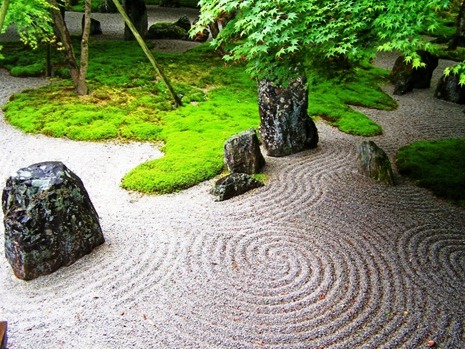
No. 2. Design principles
You can’t even imagine how exciting it is to create a project of a Japanese rock garden. First you need to decide on its location and area. The stone garden can be made the central element of the site and a decent area can be allocated for it, or you can organize it in the backyard in a small area. It all depends on your preferences and capabilities. Some give the territory under a rock garden where it is impossible to grow or build anything.When the dimensions of the designated area are known, you can proceed to design. It's better sketch diagram on paper, taking into account the following conceptual framework:
- essential principle of composition - its orientation around one point of contemplation. It is chosen depending on the time of day when a person is in the garden. By tradition, this is a point on the north side, but you can retreat from this rule;
- stones should be an odd amount. This refers to the number of relatively large stones;

- use stones of different sizes, they can be grouped into compositions of three pieces: one large boulder and two satellites, but blindly following this rule is not always worthwhile, because a rock garden should look like a part of nature, and such clear sequences do not occur in nature;
- balance between filled and empty areas. Between groups of boulders there must be free space. Pile of stones is not good. Typically, the space between the boulders is filled with small pebbles and plants. A similar solution is supported the idea of the four elements. Stones are an element of the earth. Around the large stones, the central elements of the composition, there is a small pebble with a pattern in the form of waves (symbolizes water), and the space between the boulders is the air that is vital for living plants;

- perfect if you can create heptagon garden, because this is how Japanese stone gardens are built. A different landscape will open in front of you on each side of the heptagon. In domestic conditions, the rule of the heptagon is often violated;
- the top of the skill is to arrange the stones so that one of them would not be visible from either side. This is very difficult to do, and given the free movement around the garden, the task becomes almost impossible. To get closer to a truly Japanese garden, you can define several points, the so-called viewing platforms, when viewed from which one stone will remain as if invisible;
- in price asymmetry and naturalness. Everything is in the wild;
- stones can be different in shape and size, but the main thing is that they looked natural. Round stones should resemble those that lie on the seashore, angular should give the impression that they just broke away from the cliff. No traces of human processing!

- combination of horizontal and vertical lines. Stones located horizontally should be more vertical. The Japanese are pursuing the idea of harmony and balance in everything, and there are more vertical lines on the site (fence, trees, etc.);
- it is desirable to provide three plans: front, middle and rear. In the foreground, let there be the most beautiful boulders, in the middle - pebbles with waves, and in the background - a path leading into the distance.
Rock Garden should be in harmony with the rest of the site. If you feel that it does not fit into the existing landscape very much, then it does not hinder to carry out some work on connecting the rock garden and the environment. You can, for example, lay out a few garden paths a stone facing the base of the house stone tiles or natural stone.
No. 3. Stone selection
It would seem that finding boulders of arbitrary shape is quite simple, but this is a deceptive impression. No, in principle, there is nothing super complicated in this task, but several rules must be taken into account, i.e. the first stones that come across cannot be taken. So, when choosing boulders for organizing a stone garden with your own hands, consider these nuances:
- natural look of stone. Preference is given to elements with traces of the effects of nature (leaching, growing moss, etc.);
- the colors of stones are very diverse, from very light to almost black. In terms of choosing a shade, there are no restrictions, but when choosing a specific color scheme, stick to it. It means that all stones should be in approximately the same gamut, since the Japanese style is characterized by restrained monochrome.Do not mix light and dark boulders, and it is better to refuse bright samples in general;

- pebbles, on the contrary, can be lighter than the main stones, since it symbolizes water;
- the texture of the stones should also be in harmony. For example, porous sandstone will look strange next to smooth marble.
If you did not find suitable stones on your own, then you can contact specialized stores. Sometimes they resort to the manufacture of artificial stone of arbitrary shape. In appearance, it will not differ from natural, but still it will be cheaper and more authentic to find natural boulders.
Number 4. Work sequence
In the country of the rising sun, masters when arranging a rock garden take into account many factors, including plot size, color of stones, features of the territory. For us, as for people who do not profess Zen Buddhism, this task will be much simpler. To make a rock garden with your own hands, you need adhere to this sequence of work:
- in the intended area, draw the shape of the future garden, drive along the contour of the pegs, pull the rope. Remember that the form should be as arbitrary as possible;
- level the platform and remove from it a layer of soil 10-15 cm thick using a bayonet spade;
- the soil is cleaned from the roots of weeds. Moisten the soil and leave it for 7-10 days. During this time, undetected weeds can sprout. For guarantee, herbicide treatment can be carried out;
- for better moisture removal, drainage of the soil is carried out. It is necessary to dig a plot, add baking powder to the soil (you can take expanded clayvermiculite or even granite and brick baby). If the plants will be planted in the soil, then you can add a little fertilizer and peat;

- put to the bottom geotextile, which will suppress the growth of weeds, sand pillow (about 5 cm);
- then the selected pebbles or gravel is poured to the ground level, and in the places where the boulders will be located, deepenings are made. Some people prefer to deepen the stones in the sand layer so that the composition is as stable as possible;
- we arrange boulders according to a pre-thought out scheme;
- pebbles for shrinkage can be shed with water, you will need about 1 bucket for each m2;
- the final touch is the creation of waves with a rake. So we get an imitation of water;
- You can install a curb along the edge of the stone garden. If the site is not quite horizontal, then it makes sense to install a low fence around the perimeter of the garden, which will prevent the pebbles from being washed out.

No. 5. Plants for a stone garden
Greens revitalizes the composition of stones, makes it more harmonious and natural. Plants are planted singly or in groups, choose undersized species. Juniper, yew, thuja, fir, dwarf pine, as well as dwarf varieties of mountain ash, birch, willow, are perfect for a stone garden. Of the shrubs, barberry and cotoneaster are especially held in high esteem. They have interesting leaves, an unusual crown, and in the fall they will decorate the garden with bright fruits.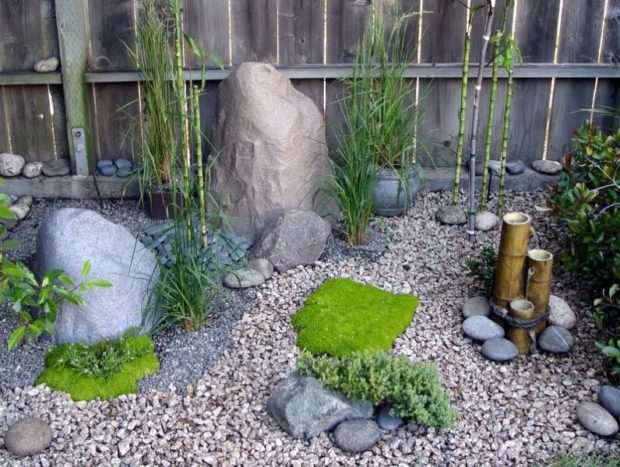
Do not bypass grassy plants. Depending on your own tastes, choose geranium, alpine edelweiss, crocuses, forget-me-nots. You can also use ground cover plants, saxifrage, Iberis, cereals. There are many suitable plants, but do not get too carried away with landscaping. The main thing in the stone garden is stones, plants serve only as decor and a frame for them. There should not be a lot of greens, so it is better to limit yourself to a small number of varieties.
Shrubs and trees are best planted before filling the site with sand and gravel. It will be much smarter this way, however, many people prefer not to plan the stone garden in advance, so they then tear apart layers of pebbles and sand to plant a plant. An alternative is to plant potted plants. Large ceramic flowerpots can become part of the composition, and small pots for herbs and flowers can be disguised as gravel.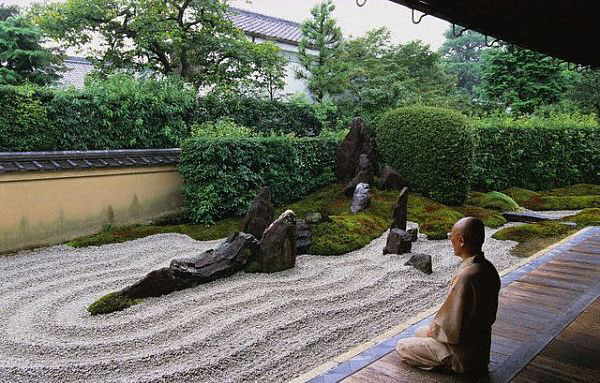
No. 6. Pond in the rock garden
In the original Japanese stone gardens, the role of water is played mainly by pebbles, which have been given a wavy shape. But we are not in Japan, so we can afford to move away from strict standards and decorate our rock garden with a small pond. From this, his serenity and tranquility will only benefit, and you will receive a bright decoration of the site.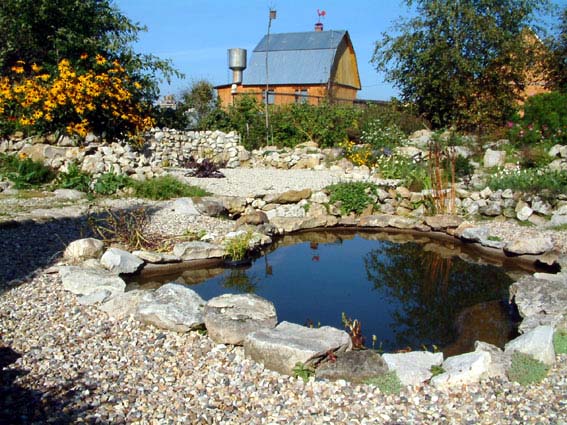
To create a pond in a rock garden, follow the following sequence of work:
- Choose a place for the reservoir, avoiding areas under tall trees;
- draw the shape of a pond on the ground, drive along the contour of the pegs, pull the rope;
- dig a hole of the necessary shape, the depth should be at least 50 cm;
- remove all weeds from the bottom, tamp the soil;
- pour river sand with a layer of at least 10 cm and compact it;
- lay down waterproofing. Black plastic film is inexpensive, but will last about 3 years. The PVC film is better than itself - it will last 15 years. The ideal option is butyl rubber rubber, whose durability reaches 30 years. Waterproofing should extend beyond the reservoir (at least 50 cm on each side). These places can be decorated with stone;
- finish - water filling and planting. You can use greens in pots. Water lilies and reeds will do.

Number 7. What else can decorate a rock garden?
In addition to boulders, plants and ponds, there may be other elements in the rock garden, but remember that decor should not be much: choose one thing, because the main role should be played by stones. Jewelry should not be distracting, they only complement the composition. As a decor, you can use:
- sinuous paths made of stone slabs, wood or round wooden saw cuts;
- stone lanterns, which will become part of the composition, as well as hidden lights that will allow you to create an effective play of light and shadows in the dark;
- bridgeswhich will be especially useful in the presence of a reservoir. Made of stone or wood;
- opaque fencesthat enhance the intimacy, privacy and tranquility of the garden;
- Tsukubai, low stone bowls, which were previously used for washing hands before the tea ceremony, now serve exclusively for decoration;
- topiary art (any shapes can be cut from plants).
A rock garden will look much more natural if you select stones and plants specific to your region. Do not abuse the variegated mixtures - they can disrupt harmony and distort the true meaning of the rock garden.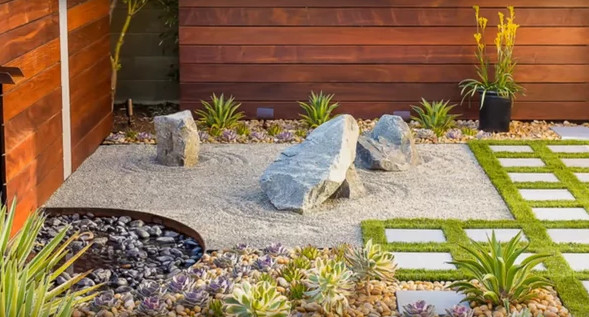
Number 8. Rock Garden Care
One of the main advantages of a rock garden is its ease of maintenance. It is as follows:
- clean gravel from debris using a stiff brush and wire rake. If the gravel is not yet compacted, you will have to select the contamination manually. The first couple of years periodically have to pour gravel;
- weeds may appear even if you carefully removed their roots and covered the ground with geotextiles. Keep track of this and pull out the sprouting stems in time;
- when used in the garden of stones plants do not forget that immediately after planting they need abundant watering, then the number of irrigations can be reduced;
- gravel retains moisture well, so plants will have to be watered infrequently. As a rule, drought-resistant plants are used for the rock garden, so there should be no problems. Fertilizers are usually not applied, since most plants suitable for stone gardens are undemanding to soil.

No. 9. Other types of stone gardens
In addition to the Japanese rock garden, there are other ways to draw attention to the beauty of the stones and fit them into the landscape of your own site. Some summer residents share their successful experience of turning one type of garden into another. In addition to the Japanese garden, there are also:
- rock garden, or rocky hill settles down on hills and slopes. If there are none on the site, they are created man-made. Plants are of great importance here;

- rockery differs from rock garden in relief - you don’t need to build a hill.There are fewer plants than in rock gardens, but more than in the Japanese rock garden;

- retaining stone wall allows you to beat the nuances of the relief of the site and divide the territory into zones. Spread such walls from different materials, and plants can decorate it on top or be in the sinuses. In the first place there is still functionality;

- terraced rock garden allows you to beat even more complex terrain. This is a combination of horizontal terraces and walls. Such a garden combines a rock garden, and retaining stone walls, and stone steps;

- gravel garden - almost the same as a rock garden, but without boulders. Suitable for small areas. Pebbles are actively decorated with bright flowers and evergreens;

- imitation of natural rocky terrain. Large stones are randomly laid out on the site, abundantly decorated with greenery and garden decor. As a result, it turns out to recreate a copy of the natural mountain landscape;

- mini rock garden can be created in a small pot by pouring small pebbles there and planting super dwarf plants, lichens and mosses. It turns out a miniature copy of a real rock garden. Such a decor would be appropriate even in a city apartment. For giving, another option is suitable. In large natural stone (suitable shell rock, limestone, pumice) create holes for plants. Some of them can be interconnected. It is better to make the lower part of the stone flat in order to put it later in a wooden pallet. In the holes, it is necessary to fill the soil and plant unpretentious plants in the care.

Admiring the stones is much more interesting and enjoyable than you might imagine. The rock garden will be a great backdrop for reflection and a way to escape from the hustle and bustle. The main thing is that you yourself can make it the way you want it to end up giving only pleasure and relaxation.

